How is IoT Related to Big Data Analytics?
Internet of Things: To Fog or to Cloud?

Cloud computing, usually just called “the cloud,” involves delivering data, applications, photos, videos, and more over the Internet to data centers. The Internet of Things, meanwhile, is the term for the connection of devices (other than the standard ones such as computers and smartphones) to the Internet. Automobiles, kitchen appliances, and even heart monitors could all be connected through the IoT. And as the Internet of Things explodes in the next few years, more types of devices will join that list.
Cloud computing and the IoT both serve to increase efficiency in our everyday tasks, and the two have a complimentary relationship. The IoT generates massive amounts of data, and cloud computing provides a pathway for that data to travel to its destination.
Some of the more popular IoT cloud platforms on the market include Amazon Web Services, GE Predix, Google Cloud IoT, Microsoft Azure IoT Suite, IBM Watson, and Salesforce IoT Cloud.
Fog computing is more than just a clever name. Also known as edge computing, it provides a way to gather and process data at local computing devices instead of in the cloud or at a remote data center. Under this model, sensors and other connected devices send data to a nearby edge computing device. This could be a gateway device, such as a switch or router, that processors and analyzes this data.
IoT Big Data & Analytics
Big data is exactly what it sounds like: it’s a lot of data. The Internet of Things is allowing us to generate more data than ever before, and the eye-popping numbers are still climbing. The “Internet of Everything,” which consists of all people and things connected to the Internet, will generate 507.5 zettabytes of data by 2019, according to Cisco. For context, one zettabyte = one trillion gigabytes.
BI Intelligence believes that fog computing will be instrumental in analyzing all of this data, as it offers several advantages that a cloud computing model simply does not have. These include quicker data analysis, reduced costs tied to data transmission, storage, and management, as well as enhanced network and application reliability.
